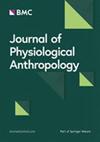来自芬兰亚北极地区驯鹿牧民的一小部分样本中的棕色脂肪组织产热
IF 3.1
4区 医学
Q1 Social Sciences
引用次数: 1
摘要
近年来,人们对人体对冷应激的生理反应的兴趣重新抬头,重点关注棕色脂肪组织(BAT),一种专门用于产热的线粒体致密脂肪。然而,大多数审查BAT的工作都是在温带气候人群中进行的。为了扩大我们对寒冷气候人群中BAT产热作用的理解,我们使用间接量热法和热成像技术,测量了室温下BAT阳性和BAT阴性区域的代谢率和体表温度,以及来自芬兰亚北极地区的驯鹿牧民(N = 22,6名女性)静息参与者的轻度冷暴露。我们发现,与胸骨相比,大多数牧民的代谢率平均显著增加8.7%,优先代谢脂肪酸,并在锁骨上区域(已知的BAT位置)保持相对较高的体表温度,而胸骨没有相关的BAT。这些结果表明,该样本中的牧民在轻度寒冷暴露下表现出活跃的BAT产热反应。这项研究增加了快速增长的关于BAT生理和体温调节意义的工作,以及它在寒冷应激人群中可能发挥的重要作用。本文章由计算机程序翻译,如有差异,请以英文原文为准。
Brown adipose tissue thermogenesis among a small sample of reindeer herders from sub-Arctic Finland
Interest in human physiological responses to cold stress have seen a resurgence in recent years with a focus on brown adipose tissue (BAT), a mitochondria dense fat specialized for heat production. However, a majority of the work examining BAT has been conducted among temperate climate populations. To expand our understanding of BAT thermogenesis in a cold climate population, we measured, using indirect calorimetry and thermal imaging, metabolic rate and body surface temperatures of BAT-positive and BAT-negative regions at room temperature, and mild cold exposure of resting participants from a small sample of reindeer herders (N = 22, 6 females) from sub-Arctic Finland. We found that most herders experienced a significant mean 8.7% increase in metabolic rates, preferentially metabolized fatty acids, and maintained relatively warmer body surface temperatures at the supraclavicular region (known BAT location) compared to the sternum, which has no associated BAT. These results indicate that the herders in this sample exhibit active BAT thermogenesis in response to mild cold exposure. This study adds to the rapidly growing body of work looking at the physiological and thermoregulatory significance of BAT and the important role it may play among cold stressed populations.
求助全文
通过发布文献求助,成功后即可免费获取论文全文。
去求助
来源期刊

Journal of Physiological Anthropology
Social Sciences-Human Factors and Ergonomics
CiteScore
4.80
自引率
6.50%
发文量
39
审稿时长
>12 weeks
期刊介绍:
Journal of Physiological Anthropology (JPA) is an open access, peer-reviewed journal that publishes research on the physiological functions of modern mankind, with an emphasis on the physical and bio-cultural effects on human adaptability to the current environment.
The objective of JPA is to evaluate physiological adaptations to modern living environments, and to publish research from different scientific fields concerned with environmental impact on human life.
Topic areas include, but are not limited to:
environmental physiology
bio-cultural environment
living environment
epigenetic adaptation
development and growth
age and sex differences
nutrition and morphology
physical fitness and health
Journal of Physiological Anthropology is the official journal of the Japan Society of Physiological Anthropology.
 求助内容:
求助内容: 应助结果提醒方式:
应助结果提醒方式:


